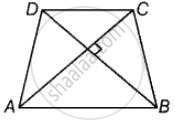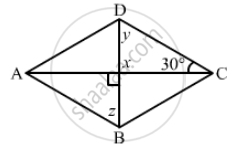Advertisements
Advertisements
Question
Diagonals of a quadrilateral are perpendicular to each other. Is such a quadrilateral always a rhombus? Give a figure to justify your answer.
Solution
It is not necessary that a quadrilateral having perpendicular diagonals is a rhombus.
E.g. Consider a trapezium ABCD in which AB || CD.

APPEARS IN
RELATED QUESTIONS
The following figure is parallelogram. Find the degree values of the unknown x, y, z.

Points E and F lie on diagonal AC of a parallelogram ABCD such that AE = CF. What type of quadrilateral is BFDE?
Which of the following statement is true for a rhombus?
It has two pairs of equal sides.
Which of the following statement is true for a rhombus?
It has all its sides of equal lengths.
Fill in the blank, in the following, so as to make the statement true:
A rhombus is a parallelogram in which ......
The diagonals of a parallelogram are not perpendicular. Is it a rhombus? Why or why not?
In a rhombus PQRS if PQ = 7.5 cm then find QR. If ∠QPS = 75° then find the measure of ∠PQR and ∠SRQ.
Lengths of diagonals of a rhombus ABCD are 16 cm and 12 cm. Find the side and perimeter of the rhombus.
ABCD is a rhombus. If ∠BCA = 35°. find ∠ADC.
ABCD is a rhombus such that the perpendicular bisector of AB passes through D. Find the angles of the rhombus.
Hint: Join BD. Then ∆ABD is equilateral.
